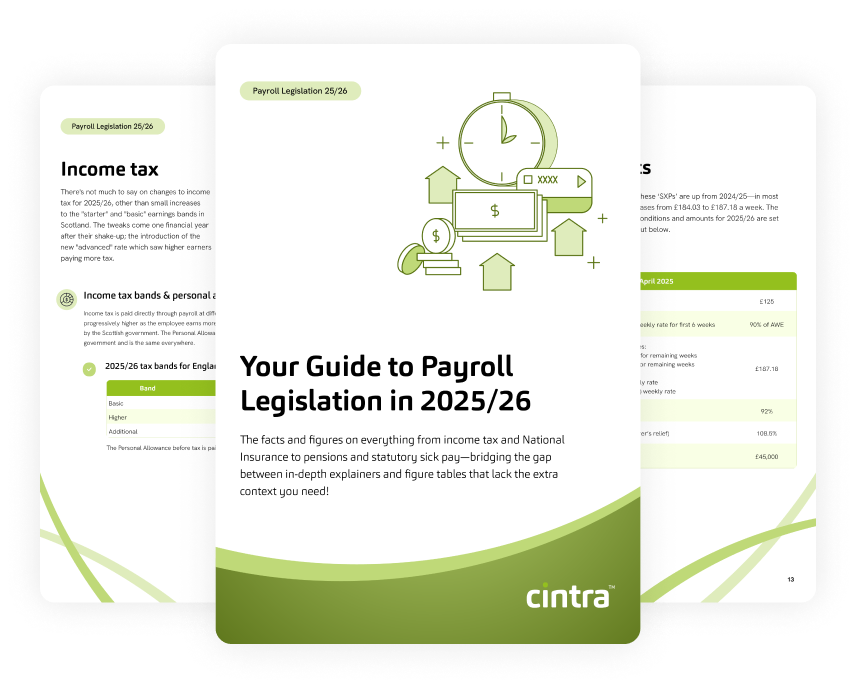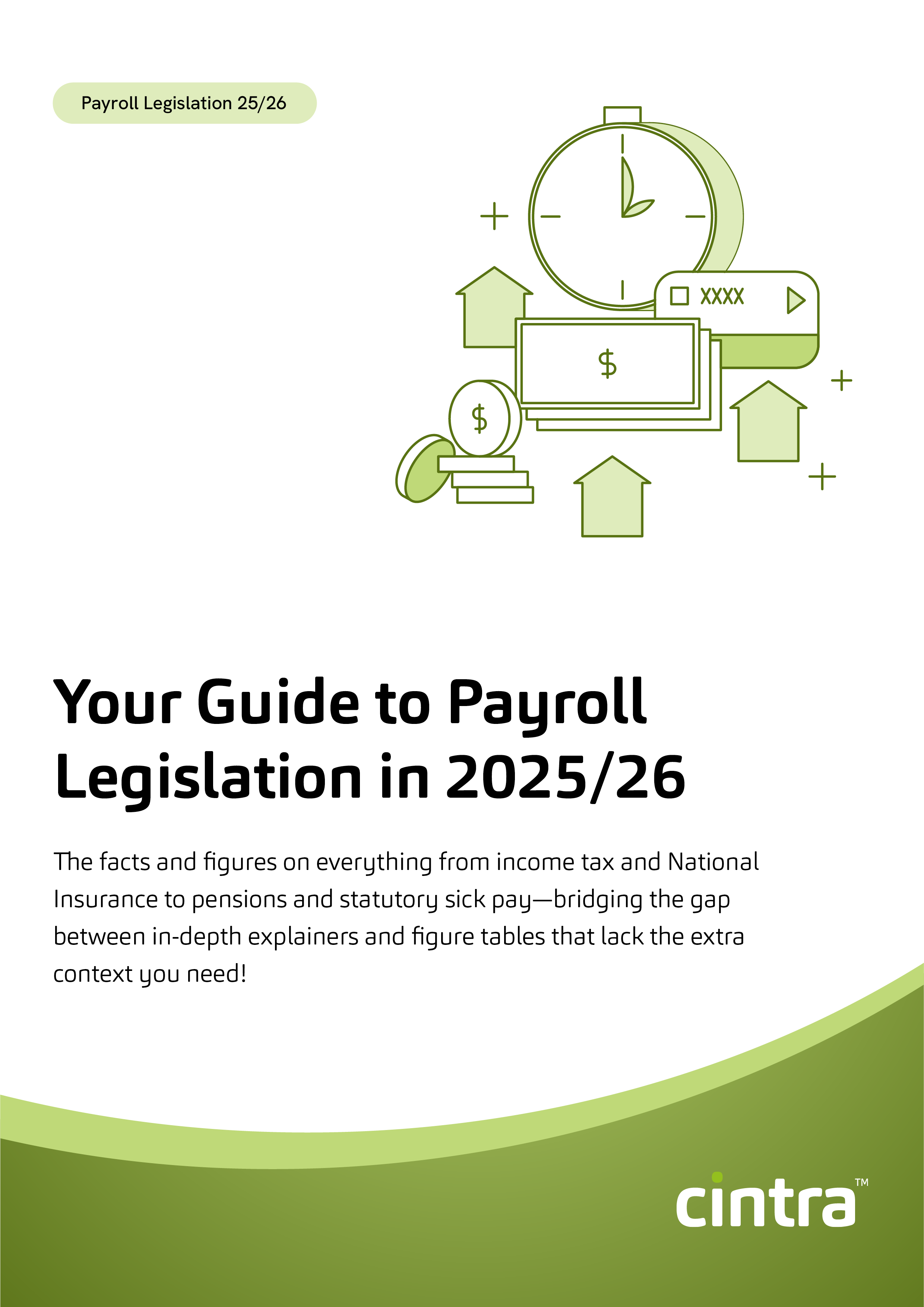Payroll deductions come in all shapes and sizes.
By understanding what you need to take from your people’s earnings, you’ll not only stay on the right side of the law but also avoid any surprises when calculating employee pay.
Let’s look at the different types of payroll deductions in the UK and how they’re calculated.
Definition of payroll deductions
Payroll deductions are amounts subtracted from an employee’s gross earnings by an employer before issuing their net pay.
These deductions can be mandatory, such as income tax, National Insurance contributions, and pension contributions, or voluntary, including health insurance premiums, employee loans and employee benefits.
Payroll deductions and their legal implications
When making payroll deductions, you must comply with various regulations:
Employment Rights Act 1996
To legally deduct money from an employee’s wages, the deduction must meet one of the following criteria:
- It’s legally required, such as tax, student loan repayments, or court-ordered payments.
- It’s stated in the employee’s contract.
- The employee has agreed to it in advance, and the agreement is in writing.
- It’s to correct an overpayment error.
- The employer is covering a cost on behalf of the employee, such as trade union membership.
- The deduction is due to missed work caused by participation in a strike or industrial action.
Income tax
When deducting income tax, it’s essential to apply the correct amount based on your employees’ tax codes. Miscalculating tax—whether by deducting too much or too little—can create unnecessary stress for both you and your employees.
Attachment of earnings order
If your employee has an attachment of earnings order (AEO), you must deduct the required amount from their wages as instructed by the court. You’ll need to calculate the deduction, apply it to their next payslip, and send the payment to the court. Once the debt is cleared, the deductions stop.
What are mandatory payroll deductions?
Mandatory payroll deductions are the ones you’re legally obliged to pay on behalf of your team. These include income tax, National Insurance contributions, workplace pensions, and student loan repayments.
Let’s take a closer look at each one:
Income tax
In the UK, employees earning up to £37,700 pay 20% income tax (after personal allowance). For earnings between £37,701 and £125,140, the rate increases to 40%, and any income over £125,140 is taxed at 45%.
Income tax brackets differ in Scotland, but you can find a full breakdown of the 2024/25 income tax rates and thresholds here.
National Insurance contributions (NICs)
Most of your employees pay Class 1 National Insurance contributions, depending on their earnings. If their pay is below the NI threshold of £242 per week (£1,048 per month), no deductions are made. Earnings above this are subject to NI contributions up to the upper earnings limit of £967 per week (£4,189 per month).
Here’s what will be deducted from your employees’ pay for 2025/26, depending on whether they are paid weekly or monthly:
Weekly rates for Class 1 NICs
| On first £242 | Nil |
| On income between £242 and £967 | 8% |
| Over £967 | 2% |
Monthly rates for Class 1 NICs
| On first £1048 | Nil |
| On income between £1048 and £4189 | 8% |
| Over £4189 | 2% |
Workplace pension contributions
You’re legally required to enrol eligible employees in a workplace pension scheme and contribute to it. This process, known as auto enrolment, helps your team save for their future.
Here’s how it works:
- Your employees contribute a minimum of 5% of their salary towards their pension.
- You must add at least 3%.
- The government provides tax relief, further increasing the pension pot.
For 2025/26, only earnings above £6,240 count towards pension contributions. So, if an employee earns £22,308, their pensionable earnings would be £16,068, and your 3% employer contribution would amount to £482 per year.
Student loan repayments
Former students must start repaying their loans once they earn above a certain threshold.
You’re required to deduct 9% of their income above the threshold, depending on the student loan plan they have.
For Postgraduate Loans (PGL), only 6% of earnings above the threshold are deducted.
Here are the student loan repayment thresholds for 2025/26:
| Plan | Threshold |
|---|---|
| 1 | £26,065/year |
| 2 | £28,470/year |
| 4 | £32,745/year |
| PGL | £21,000/year |
It’s worth mentioning that repayments for student loans are calculated on gross income, but as an employer you’ll deduct them from their net income.
Payroll deduction reporting requirements
It’s one thing to deduct correctly, but it’s another to report it correctly.
For student loans
The Student Loans Company issues the loans, but repayments are collected through HMRC via the PAYE system. As an employer, you have a legal obligation to inform HMRC on the “New Starter” form if your employee has a student loan to repay.
Additionally, it’s important to include student loan deductions on the Full Payment Submission (FPS) for each employee with an active loan repayment.
The Student Loans Company will also notify HMRC if your employee has a student loan or Postgraduate Loan (PGL) to repay, and when repayments should begin.
HMRC will then send you a “Start Notice” to signal the start of deductions. If deductions need to be stopped, you’ll receive a “Stop Notice”.
For Income tax
HMRC is responsible for collecting income tax deductions.
To report these deductions, you must submit a Full Payment Submission (FPS) to HMRC. This should be done on or before your employees’ payday.
For employee benefits
When you’re offering employee benefits, it’s your responsibility to report any taxable benefits to HMRC. You can do this either through your payroll system during the year or online after the year-end, but the deadline is July 6.
If you’re reporting through payroll, everything will be handled through Real Time Information (RTI), and the tax will be paid throughout the year. This means you won’t need to report individual benefits for each team member at the end of the tax year, but you’ll still need to report any Class 1A National Insurance you owe by July 19. This can be done online by submitting a P11D(b) form.
If you prefer to report after the year-end, you’ll need to send a P11D for each employee who received benefits, and also submit a report for any Class 1A National Insurance due.
A good payroll software provider like Cintra can help with P11D forms, or you can use HMRC’s PAYE Online Service for P11D filing (if you have fewer than 500 employees).
It’s also worth mentioning that from April 2026, all benefits in kind (except for loans and living accommodation) must be reported and taxed through payroll. Which means that you’ll no longer be able to process BIKs through P11Ds.
Get the latest insights and best practice guides, direct to your inbox.
What are voluntary payroll deductions?
The only difference between voluntary deductions and mandatory deductions is that an employee expressly agrees to have voluntary deductions made from their pay packet in exchange for things like health insurance premiums or employee loans, for example.
To give you more of an idea of what a voluntary deduction looks like, here are some examples:
Health insurance premiums
It’s not always possible to include health insurance in your perks package. If this is the case, offering it as a voluntary deduction may well be a possible option.
Employees can sacrifice some of their salary each month to pay for this. The amount will depend on the type of plan they pick. Their monthly deduction for health insurance may cover routine GP appointments, prescriptions and diagnostic testing, right up to surgery.
Employee loans
An employee loan is another example of a voluntary deduction. As an employer, you’re able to offer up to £10,000 tax free to your people, without paying any tax or National Insurance.
There are a few kinds of loans available. Your employee may take advantage of a season ticket loan to help them pay for their commute, or an advance on their salary. In most cases, a team member can get up to half of their (accrued) salary in advance. Any loan they take out with you will be deducted from their wage each month in order to pay it back.
Employee benefits
Certain employee benefits can be deducted from your team’s pay. These may include perks such as gym memberships, cycle to work schemes and life insurance. The salary sacrifice may subsidise the benefit or cover it completely.
Charity donations
If an employee wishes to contribute to charity on a monthly basis through a wage deduction, this is known as Payroll Giving. This scheme enables employees to make charitable donations without incurring tax on the contribution, provided it is processed through PAYE.
Pension contributions
As you now know, you’re legally required to enrol your team in a workplace pension.
Employees also have the option to make additional contributions to their pension pot, which will result in an extra deduction from their salary.
How to calculate payroll deductions
Imagine you run a small business, and you have an employee, Sarah, who earns £2,500 per month (£30,000 per year) before any deductions—this is her gross pay.
Now, to figure out what actually lands in her bank account (net pay), you need to account for mandatory payroll deductions, including tax, National Insurance, and pension contributions (you know, all the things we’ve covered above).
Step 1. Deduct income tax
In the UK, everyone is entitled to a tax-free personal allowance, which for 2025/26 is £12,570 per year.
That means Sarah won’t pay tax on the first £1,047.50 (£12,570 /12) she earns each month.
However, the rest is taxed:
- Sarah’s monthly taxable income = £2,500 – £1,047.50 = £1,452.50
- The basic rate of income tax (20%) applies:
- 20% of £1,452.50 = £290.50 deducted for income tax
Step 2. Deduct National Insurance
As Sarah earns between £1,048 and £4,189 a month, she’ll pay 8% in National Insurance contributions.
So:
- Sarah’s NI taxable income = £2,500 – £1,048 = £1,452
- 8% of £1,452 = £116.16 deducted for NI
Step 3. Deduct pension contributions
Sarah is in a workplace pension scheme, so she contributes 5% of her earnings above £520 per month (the pensionable threshold for 2025/26).
- Sarah’s pensionable income = £2,500 – £520 = £1,980
- 5% of £1,980 = £99 deducted for her pension
- As her employer, you also contribute at least 3% (£59.40), but that doesn’t come out of her salary—it’s an extra benefit for her!
Step 4. Calculate net pay
Now, let’s add up Sarah’s payroll deductions:
- Income tax: £290.50
- National Insurance: £116.16
- Pension contributions: £99
Total payroll deductions = £505.66
So, Sarah’s net pay (the amount she actually takes home) is:
£2,500 – £505.66 = 1,994.34
Cintra can manage all your payroll deductions
If you have multiple employees, managing payroll deductions manually can quickly become overwhelming.
That’s where payroll software like Cintra comes in. It automates all the calculations, updates tax codes, and keeps you compliant with HMRC—helping you avoid the risk of underpaying or overpaying your staff.
Get in touch today for your very own demo.

Payroll Legislation Guide
The facts, figures, thresholds and allowances for 2025/26 spanning tax, National Insurance, pensions, statutory payments and more.
Download now


